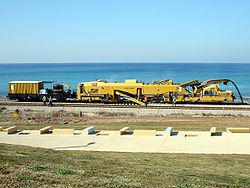
Ballast cleaner
Encyclopedia

Track ballast
Track ballast forms the trackbed upon which railway sleepers or railroad ties are laid. It is packed between, below, and around the ties. It is used to facilitate drainage of water, to distribute the load from the railroad ties, and also to keep down vegetation that might interfere with the track...
(gravel, blue stone or other aggregate
Construction Aggregate
Construction aggregate, or simply "aggregate", is a broad category of coarse particulate material used in construction, including sand, gravel, crushed stone, slag, recycled concrete and geosynthetic aggregates. Aggregates are the most mined material in the world...
) of impurities.
Over time, ballast becomes worn, and loses its angularity, becoming rounded. This hinders the tessellation of pieces of ballast with one another, and thus reduces its effectiveness. Fine pieces of granite, like sand, are also created by attrition, known simply as "fines". Combined with water in the ballast, these fines stick together, making the ballast like a lump of concrete. This hinders both track drainage and the flexibility of the ballast to constrain the track as it moves under traffic.
Ballast cleaning removes this worn ballast, screens it and replaces the "dirty" worn ballast with fresh ballast. The advantage of ballast cleaning is that it can be done by an on-track machine without removing the rail and sleepers, and it is therefore cheaper than a total excavation.
A cutter bar runs beneath sleeper level excavating all of the ballast under the sleepers to a specified, variable depth. A conveyor then moves the ballast into the cleaner, where it passes through a mesh. Pieces of ballast which are smaller than the mesh size fall through and are rejected, those that are bigger than the mesh are returned to the track along with fresh ballast. The ballast cleaner has both ballast and spoil wagons attached to it, to which the materials are fed by a series of conveyor belts. This process can be done in short possessions, meaning that track life can be considerably extended with the minimum of disruption.
In 2008, Network Rail
Network Rail
Network Rail is the government-created owner and operator of most of the rail infrastructure in Great Britain .; it is not responsible for railway infrastructure in Northern Ireland...
purchased a new high output ballast cleaner to do this work contiously at high speed along main line routes. The train is approximately a quarter of a mile long.
External links
- http://www.grandadsez.co.uk/railways/ballast-cleaners.html Technical Information
- http://www.networkrail.co.uk/aspx/4538.aspx Network Rail purchase a new High Output ballast cleaner

